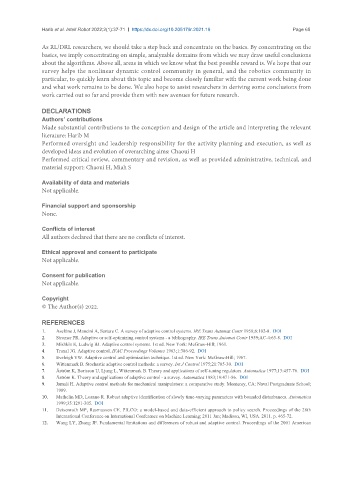Page 71 - Read Online
P. 71
Harib et al. Intell Robot 2022;2(1):37-71 https://dx.doi.org/10.20517/ir.2021.19 Page 65
As RL/DRL researchers, we should take a step back and concentrate on the basics. By concentrating on the
basics, we imply concentrating on simple, analyzable domains from which we may draw useful conclusions
about the algorithms. Above all, areas in which we know what the best possible reward is. We hope that our
survey helps the nonlinear dynamic control community in general, and the robotics community in
particular, to quickly learn about this topic and become closely familiar with the current work being done
and what work remains to be done. We also hope to assist researchers in deriving some conclusions from
work carried out so far and provide them with new avenues for future research.
DECLARATIONS
Authors’ contributions
Made substantial contributions to the conception and design of the article and interpreting the relevant
literature: Harib M
Performed oversight and leadership responsibility for the activity planning and execution, as well as
developed ideas and evolution of overarching aims: Chaoui H
Performed critical review, commentary and revision, as well as provided administrative, technical, and
material support: Chaoui H, Miah S
Availability of data and materials
Not applicable.
Financial support and sponsorship
None.
Conflicts of interest
All authors declared that there are no conflicts of interest.
Ethical approval and consent to participate
Not applicable.
Consent for publication
Not applicable.
Copyright
© The Author(s) 2022.
REFERENCES
1. Aseltine J, Mancini A, Sarture C. A survey of adaptive control systems. IRE Trans Automat Contr 1958;6:102-8. DOI
2. Stromer PR. Adaptive or self-optimizing control systems - a bibliography. IRE Trans Automat Contr 1959;AC-4:65-8. DOI
3. Mishkin E, Ludwig BJ. Adaptive control systems. 1st ed. New York: McGraw-Hill; 1961.
4. Truxal JG. Adaptive control. IFAC Proceedings Volumes 1963;1:386-92. DOI
5. Eveleigh VW. Adaptive control and optimization technique. 1st ed. New York: McGraw-Hill; 1967.
6. Wittenmark B. Stochastic adaptive control methods: a survey. Int J Control 1975;21:705-30. DOI
7. Åström K, Borisson U, Ljung L, Wittenmark B. Theory and applications of self-tuning regulators. Automatica 1977;13:457-76. DOI
8. Åström K. Theory and applications of adaptive control - a survey. Automatica 1983;19:471-86. DOI
9. Jamali H. Adaptive control methods for mechanical manipulators: a comparative study. Monterey, CA: Naval Postgraduate School;
1989.
10. Mathelin MD, Lozano R. Robust adaptive identification of slowly time-varying parameters with bounded disturbances. Automatica
1999;35:1291-305. DOI
11. Deisenroth MP, Rasmussen CE. PILCO: a model-based and data-efficient approach to policy search. Proceedings of the 28th
International Conference on International Conference on Machine Learning; 2011 Jun; Madison, WI, USA. 2011. p. 465-72.
12. Wang LY, Zhang JF. Fundamental limitations and differences of robust and adaptive control. Proceedings of the 2001 American

